First Results of Integrated Geoarchaeological Analyses in the Capua Territory (Campania, Italy)
Abstract
:1. Introduction
2. Geological Setting of the Study Area
3. Materials and Methods
3.1. Morphostratigraphical Analysis
3.2. Palynological Analysis
3.3. Archeometric Analysis
- Sample 1—1.70 m depth—mortar-like material;
- Sample 2—1.90 m depth—worked stone-like material;
- Sample 3—2.00 m depth—brick-like material.
- -
- CuKα radiation, 40 kV, and 40 mA;
- -
- 2θ interval from (analytical range of) 4 to 50° and step size equal to 0.020° 2θ;
- -
- counting time equal to 120 s time per step.
3.4. Radiocarbon Analysis
- (i)
- Sample is weighed into quartz tubes (outer diameter of 6 mm and inner diameter of 4 mm) with a sufficient amount of CuO rods (approximately 30 mg) to ensure the complete combustion of the produced soil organic carbon; ii) the quartz tube is attached by Swagelock Utratorr fittings to a high-vacuum line (i.e., <10−6 mbar), evacuated to avoid possible contamination, and sealed with an oxypropane torch capable of reaching 1300 °C. The sealed tube containing the sample and CuO is placed on a grid in a muffle furnace at 920 °C for 6.5 h.
- (ii)
- Among the combustion products (e.g., CO2, H2O, NO2, SO2), only CO2, which preserves the chronological information of the sample, is isolated using a cryogenic line trapping H2O and CO2 in selective cryogenic traps and allowing the removal of other gases (non-condensable) through a pumping system.
- (iii)
- Isolated CO2 undergoes a final transformation (reduction to graphite) before measurement. Specifically, purified CO2 is transferred into 9 mm Pyrex tubes containing a mixture of reagents (Zn (37.5 mg) and TiH2 (11 mg)) that will reduce the CO2 to graphite and a 6 mm tube containing 3 mg of Fe powder, which acts as a catalyst for the reaction. The sample then undergoes the Sealed Tube Zinc Reduction reaction at 560 °C for 8 h.
- (iv)
- Produced graphite is finally pressed together with Fe powder into aluminum cathodes and mounted in a carousel of 40 samples, along with a series of blank and reference samples (with known 14C content) for measurement with the CIRCE AMS system [47]. The measured isotopic ratios are converted into radiocarbon ages [48] and calibrated using Oxcal 4.4 [49] and the INTCAL22 [50] calibration dataset. For each sample, results are reported as calendric age intervals at 1 and 2 sigma.
4. Results
4.1. Morphostratigraphical Setting of the Capua Territory
4.2. Chronology
4.3. Landscape and Land Use
4.4. Archeometry
5. Discussion
6. Conclusions
Author Contributions
Funding
Data Availability Statement
Acknowledgments
Conflicts of Interest
References
- Cornell, T.J. The Beginnings of Rome; Routledge: London, UK, 1995. [Google Scholar]
- DeLacey, L. Capua: Roman, Early Christian and Medieval Archaeology; J. Paul Getty Museum: Los Angeles, CA, USA, 2003. [Google Scholar]
- Durrant, H.F.P. The History of the Norman Kingdom of Sicily; Oxford University Press: Oxford, UK, 1961. [Google Scholar]
- Di Resta, I. Capua Medievale. La Città dal IX al XIII Secolo e L’architettura dell’età Longobarda; Liguori Editore: Napoli, Italy, 1983. [Google Scholar]
- Pane, G.; Filangieri, A. Capua. Architettura e arte: Catalogo Delle Opere; Edizioni Capuanuova: Vitulazio, Italy, 1994; Volumes 1–2. [Google Scholar]
- Peduto, P. Quanto rimane di Salerno e di Capua longobarde (secc. VIII–IX). In I Longobardi del Sud; Giorgio Bretschneider Editore: Roma, Italy, 2010; pp. 257–278. [Google Scholar]
- Brogiolo, G.P. Le Origini Della Città Medievale; Società Archeologica: Mantova, Italy, 2011. [Google Scholar]
- Brogiolo, G.P.; Gelichi, S. La Città Nell’alto Medioevo Italiano. Archeologia e Storia, 9th ed.; Laterza: Roma, Italy, 2012. [Google Scholar]
- Augenti, A. Archeologia Della Città Medievale. 2014; pp. 173–182. Available online: https://www.torrossa.com/en/resources/an/3015868 (accessed on 20 March 2025).
- Gelichi, S. Archeologia urbana e storia della città altomedievale: Quale futuro. In Dalla Valdelsa al Conero. Ricerche di Archeologia e Topografia in Ricordo di Giuliano de Marinis; Baldini, G., Giroldini, P., Eds.; Edizioni All’Insegna del Giglio: Firenze, Italy, 2016; pp. 163–168. [Google Scholar]
- Di Luzio, E.; Carfora, P. Approcci Multidisciplinari per la Ricostruzione del Paesaggio di Una Grande Strada Romana. La via Appia al Valico Degli Aurunci; Claudio Grenzi Editore: Foggia, Italy, 2019. [Google Scholar]
- Corrado, G.; Amodio, S.; Aucelli, P.P.C.; Pappone, G.; Schiattarella, M. The Subsurface Geology and Landscape Evolution of the Volturno Coastal Plain, Italy: Interplay between Tectonics and Sea-Level Changes during the Quaternary. Water 2020, 12, 3386. [Google Scholar] [CrossRef]
- Mozzi, P.; Ferrarese, F.; Zangrando, D.; Gamba, M.; Vigoni, A.; Sainati, C.; Fontana, A.; Ninfo, A.; Piovan, S.; Rossato, S.; et al. The modeling of archaeological and geomorphic surfaces in a multistratified urban site in Padua, Italy. Geoarchaeology 2017, 33, 67–84. [Google Scholar] [CrossRef]
- Amato, V.; Ciarcia, S.; Rossi, A.; Santoriello, A. The urban geoarchaeology of Benevento, Southern Italy: Evaluating archaeological potential. Geoarchaeology 2017, 33, 100–111. [Google Scholar] [CrossRef]
- Pagano, M.; Tomeo, A. Capua. La Seconda Roma; Edizioni Belle Epoque: Napoli, Italy, 2021. [Google Scholar]
- Quilici Gigli, S. La via Appia nella Campania settentrionale. Apporti dalle immagini aeree e satellitari. Archeol. Aerea 2020, 14, 83–92. [Google Scholar]
- Quilici Gigli, S. La Via Appia nella Campania settentrionale, suoi principali allacciamenti e diramazioni. Orizzonti Rass. Di Archeol. 2022, 23, 193–205. [Google Scholar]
- Di Rita, F.; Lirer, F.; Bonomo, S.; Cascella, A.; Ferraro, L.; Florindo, F.; Insinga, D.D.; Lurcock, P.C.; Margaritelli, G.; Petrosino, P.; et al. Late Holocene forest dynamics in the Gulf of Gaeta (central Mediterranean) in relation to NAO variability and human impact. Quat. Sci. Rev. 2018, 179, 137–152. [Google Scholar] [CrossRef]
- Di Lorenzo, H.; Di Donato, V.; Molisso, F.; Lubritto, C.; Russo Ermolli, E. A high-resolution record of landscape changes and land use over the last 5000 years in western Calabria (S. Eufemia Gulf, southern Tyrrhenian Sea, Italy). Holocene 2021, 33, 1045–1059. [Google Scholar] [CrossRef]
- Sadori, L. The Lateglacial and Holocene vegetation and climate history of Lago di Mezzano (central Italy). Quat. Sci. Rev. 2018, 202, 30–44. [Google Scholar] [CrossRef]
- Santangelo, N.; Romano, P.; Ascione, A.; Russo Ermolli, E. Quaternary evolution of the Southern Apennines coastal plains: A review. Geol. Carpath. 2017, 68, 43–56. [Google Scholar] [CrossRef]
- Cinque, A.; Patacca, E.; Scandone, P.; Tozzi, M. Quaternary kinematic evolution of the Southern Apennines. Relationships between surface geological features and deep lithospheric structures. Ann. Geophys.-Italy 1993, 36, 249–259. [Google Scholar]
- Turco, E.; Macchiavelli, C.; Mazzoli, S.; Schettino, A.; Pierantoni, P.P. Kinematic evolution of Alpine Corsica in the framework of Mediterranean mountain belts. Tectonophysics 2012, 579, 193–206. [Google Scholar] [CrossRef]
- Patacca, E.; Scandone, P. Geology of the Southern Apennines. Ital. J. Geosci. 2007, 7, 75–119. [Google Scholar]
- Jolivet, L.; Faccenna, C. Mediterranean extension and the Africa-Eurasia collision. Tectonics 2000, 19, 1095–1106. [Google Scholar] [CrossRef]
- Turco, E.; Schettino, A.; Pierantoni, P.P.; Santarelli, G. Chapter 2 The Pleistocene extension of the Campania Plain in the framework of the southern Tyrrhenian tectonic evolution: Morphotectonic analysis, kinematic model and implications for volcanism. In Developments in Volcanology; De Vivo, B., Ed.; Elsevier: Amsterdam, The Netherlands, 2006; Volume 9, pp. 27–51. [Google Scholar] [CrossRef]
- Brocchini, D.; Principe, C.; Castradori, D.; Laurenzi, M.A.; Gorla, L. Quaternary evolution of the southern sector of the Campania Plain and early Somma-Vesuvius activity: Insights from the Trecase 1 well. Miner. Petrol. 2001, 73, 67–91. [Google Scholar] [CrossRef]
- Amato, V.; Aucelli, P.P.C.; Bellucci Sessa, E.; Cesarano, M.; Incontri, P.; Pappone, G.; Valente, E.; Vilardo, G. Multidisciplinary approach for fault detection: Integration of PS-InSAR, geomorphological, stratigraphic and structural data in the Venafro intermontane basin (Central-Southern Apennines, Italy). Geomorphology 2017, 283, 80–101. [Google Scholar] [CrossRef]
- Giano, S.I.; Gioia, D.; Schiattarella, M. Morphotectonic evolution of connected intermontane basins from the southern Apennines, Italy: The legacy of the pre-existing structurally controlled landscape. Rend. Fis. Acc. Lincei 2014, 25, 241–252. [Google Scholar] [CrossRef]
- Giaccio, B.; Hajdas, I.; Isaia, R.; Deino, A.; Nomade, S. High-precision 14C and 40Ar/39Ar dating of the Campanian Ignimbrite (Y-5) reconciles the time-scales of climatic-cultural processes at 40 ka. Sci. Rep. 2017, 7, 45940. [Google Scholar] [CrossRef]
- Totaro, F.; Petrosino, P.; Valente, E.; Arienzo, I.; D’Antonio, M.; Di Vito, M.; Giaccio, B.; Jicha, B.J.; Petrelli, M.; Santangelo, N.; et al. Last interglacial paleoshoreline location and tectono-stratigraphic evolution of the peri-Tyrrhenian Sarno basin, southern Italy, constrained by tephrostratigraphy. Earth Surf. Process. Landoforms 2025, 50, 6039. [Google Scholar] [CrossRef]
- Cusano, A.; Lo Curzio, S.; Magliulo, P.; Russo, F.; Valente, E. Geomorphological changes and land-use variations of the Lower Volturno River (Southern Italy) by Cartography and Remote sensing imagery: Preliminary results. Rend. Online Soc. Geol. It. 2023, 61, 70–76. [Google Scholar] [CrossRef]
- Mercuri, A.M.; Sadori, L.; Blasi, C. Archaeobotany for cultural landscape and human impact reconstructions. Plant Biosyst. 2010, 144, 860–864. [Google Scholar] [CrossRef]
- Sadori, L.; Jahns, S.; Peyron, O. Mid-Holocene vegetation history of the central Mediterranean. Holocene 2011, 21, 117–129. [Google Scholar] [CrossRef]
- Mercuri, A.M. Genesis and evolution of the cultural landscape in central Mediterranean: The ‘where, when and how’ through the palynological approach. Land. Ecol. 2014, 29, 1799–1810. [Google Scholar] [CrossRef]
- Mensing, S.A.; Tunno, I.; Sagnotti, L.; Florindo, F.; Noble, P.; Archer, C.; Zimmerman, S.; Pavón-Carrasco, F.J.; Cifani, G.; Passigli, S.; et al. 2700 years of Mediterranean environmental change in central Italy: A synthesis of sedimentary and cultural records to interpret past impacts of climate on society. Quat. Sci. Rev. 2015, 116, 72–94. [Google Scholar] [CrossRef]
- Russo Ermolli, E.; Di Lorenzo, H.; Santangelo, N.; Santo, A.; Comegna, C.; Petrosino, P. Unravelling 6000 years of interplay among environmental changes, anthropogenic activities, and Vesuvius eruptions in the upper Sarno Plain (Campania, Italy). Quat. Res. 2024, 1–22. [Google Scholar] [CrossRef]
- Mercuri, A.M.; Bandini, M.M.; Florenzano, A.; Montecchi, M.C.; Rattighieri, E.; Torri, P. Anthropogenic Pollen Indicators (API) from archaeological sites as local evidence of human-induced environments in the Italian Peninsula. Ann. Bot. 2013, 3, 143–153. [Google Scholar] [CrossRef]
- Florenzano, A. The History of Pastoral Activities in S Italy Inferred from Palynology: A Long-Term Perspective to Support Biodiversity Awareness. Sustainability 2019, 11, 404. [Google Scholar] [CrossRef]
- Di Lorenzo, H.; Aucelli, P.; Corrado, G.; De Iorio, M.; Schiattarella, M.; Russo Ermolli, E. Environmental evolution and anthropogenic forcing in the Garigliano coastal plain (Italy) during the Holocene. Holocene 2021, 31, 1089–1099. [Google Scholar] [CrossRef]
- Mazier, F.; Galop, D.; Gaillard, M.J.; Rendu, C.; Cugny, C.; Legaz, A.; Peyron, O.; Buttler, A. Multidisciplinary approach to reconstruct pastoral activities. An example from the Pyrenean Mountains (Pays Basque). Holocene 2009, 19, 171–178. [Google Scholar] [CrossRef]
- Brun, C. Anthropogenic indicators in pollen diagrams in eastern France: A critical review. Veg. Hist. Archaeobot. 2011, 20, 135–142. [Google Scholar] [CrossRef]
- Ejarque, A.; Miras, Y.; Riera, S. Pollen and Non-Pollen palynomorph indicators of vegetation and highland grazing activities obtained from modern surface and dung datasets in the eastern Pyrenees. Rev. Palaeobot. Palynol. 2011, 167, 123–139. [Google Scholar] [CrossRef]
- Deza-Araujo, M.; Morales-Molino, C.; Tinner, W.; Henne, P.D.; Heitz, C.; Pezzatti, G.B.; Hafner, A.; Conedera, M.A. Critical assessment of human-impact indices based on anthropogenic pollen indicators. Quat. Sci. Rev. 2020, 236, 106291. [Google Scholar] [CrossRef]
- Passariello, I.; Marzaioli, F.; Lubritto, C.; Rubino, M.; D’Onofrio, A.; de Cesare, N.; Borriello, G.; Casa, G.; Palmieri, A.; Rogalla, D.; et al. Radiocarbon sam-ple preparation at the CIRCE AMS laboratory in Caserta, Italy. Radiocarbon 2007, 49, 225–232. [Google Scholar] [CrossRef]
- Marzaioli, F.; Borriello, G.; Passariello, I.; Lubritto, C.; de Cesare, N.; D’Onofrio, A.; Terrasi, F. Zinc reduction as an alternative method for AMS radiocarbon dating: Process optimization at CIRCE. Radiocarbon 2008, 50, 139–149. [Google Scholar] [CrossRef]
- Terrasi, F.; De Cesare, N.; D’Onofrio, A.; Lubritto, C.; Marzaioli, F.; Passariello, I.; Rogalla, D.; Sabbarese, C.; Borriello, G.; Casa, G.; et al. High precision 14C AMS at CIRCE (2008) Nucl. Instrum. Methods Phys. Res. B 2008, 266, 2221–2224. [Google Scholar] [CrossRef]
- Stuiver, M.; Polach, H.A. Discussion: Reporting of 14C data. Radiocarbon 1977, 19, 355–363. [Google Scholar] [CrossRef]
- Bronk Ramsey, C. Bayesian analysis of radiocarbon dates. Radiocarbon 2009, 51, 337–360. [Google Scholar] [CrossRef]
- Reimer, P.J.; Austin, W.E.N.; Bard, E.; Bayliss, A.; Blackwell, P.G.; Bronk Ramsey, C.; Butzin, M.; Cheng, H.; Edwards, R.L.; Friedrich, M.; et al. The IntCal22 Northern Hemisphere Radiocarbon Age Calibration Curve (0–55 cal kBP). Radiocarbon 2022, 64, 725–757. [Google Scholar]
- La Russa, M.F.; Ruffolo, S.A.; Ricca, M.; Rovella, N.; Comite, V.; Alvarez de Buergo, M.; Barca, D.; Crisci, G.M. Archaeometric approach for the study of mortars from the underwater archaeological site of Baia (Naples) Italy: Preliminary results. Period. Mineral. 2015, 3, 553–567. [Google Scholar]
- Graziano, S.F.; Di Benedetto, C.; Guarino, V.; Rispoli, C.; Munzi, P.; Cappelletti, P.; Morra, V. Technology and building materials in Roman age (1st BC–2nd AD): The “Mausoleo Della Sfinge” from the archaeological site of Cuma (Italy). Mediterr. Archaeol. Archaeom. 2018, 18, 81–94. [Google Scholar] [CrossRef]
- Fichera, G.V.; Belfiore, C.M.; La Russa, M.F.; Ruffolo, S.A.; Barca, D.; Frontoni, R.; Galli, G.; Pezzino, A. Limestone provenance in Roman lime-volcanic ash mortars from the Villa dei Quintili, Rome. Geoarch 2015, 30, 79–99. [Google Scholar] [CrossRef]
- Rispoli, C.; Montesano, G.; Verde, M.; Balassone, G.; Columbu, S.; De Bonis, A.; Di Benedetto, C.; D’Uva, F.; Esposito, R.; Graziano, S.F.; et al. The key to ancient Roman mortars hydraulicity: Ceramic fragments or volcanic materials? A lesson from the Phlegrean archaeological area (southern Italy). Constr. Build. Mater. 2024, 411, 134408. [Google Scholar] [CrossRef]
- Aiello, G.; Barra, D.; De Pippo, T.; Donadio, C.; Miele, P.; Russo Ermolli, E. Morphological and paleoenvironmental evolution of the Vendicio coastal plain in the Holocene (Latium, Central Italy). Alp. Mediterr. Quat. 2007, 20, 185–194. [Google Scholar]
- Florenzano, A.; Marignani, M.; Rosati, L.; Fascetti, S.; Mercuri, A.M. Are Cichorieae an indicator of open habitats and pastoralism in current and past vegetation studies? Plant Biosyst. 2015, 149, 154–165. [Google Scholar] [CrossRef]



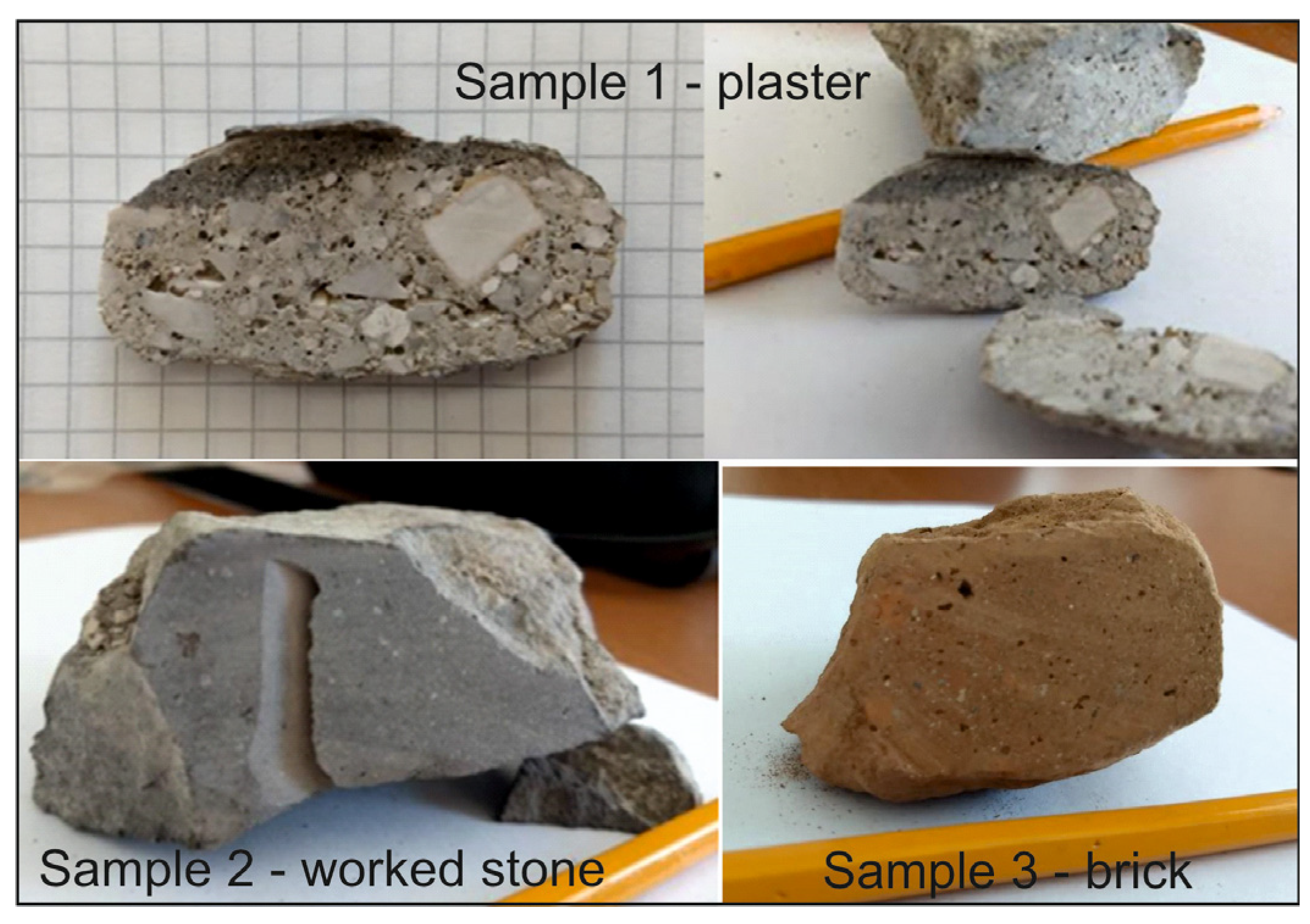
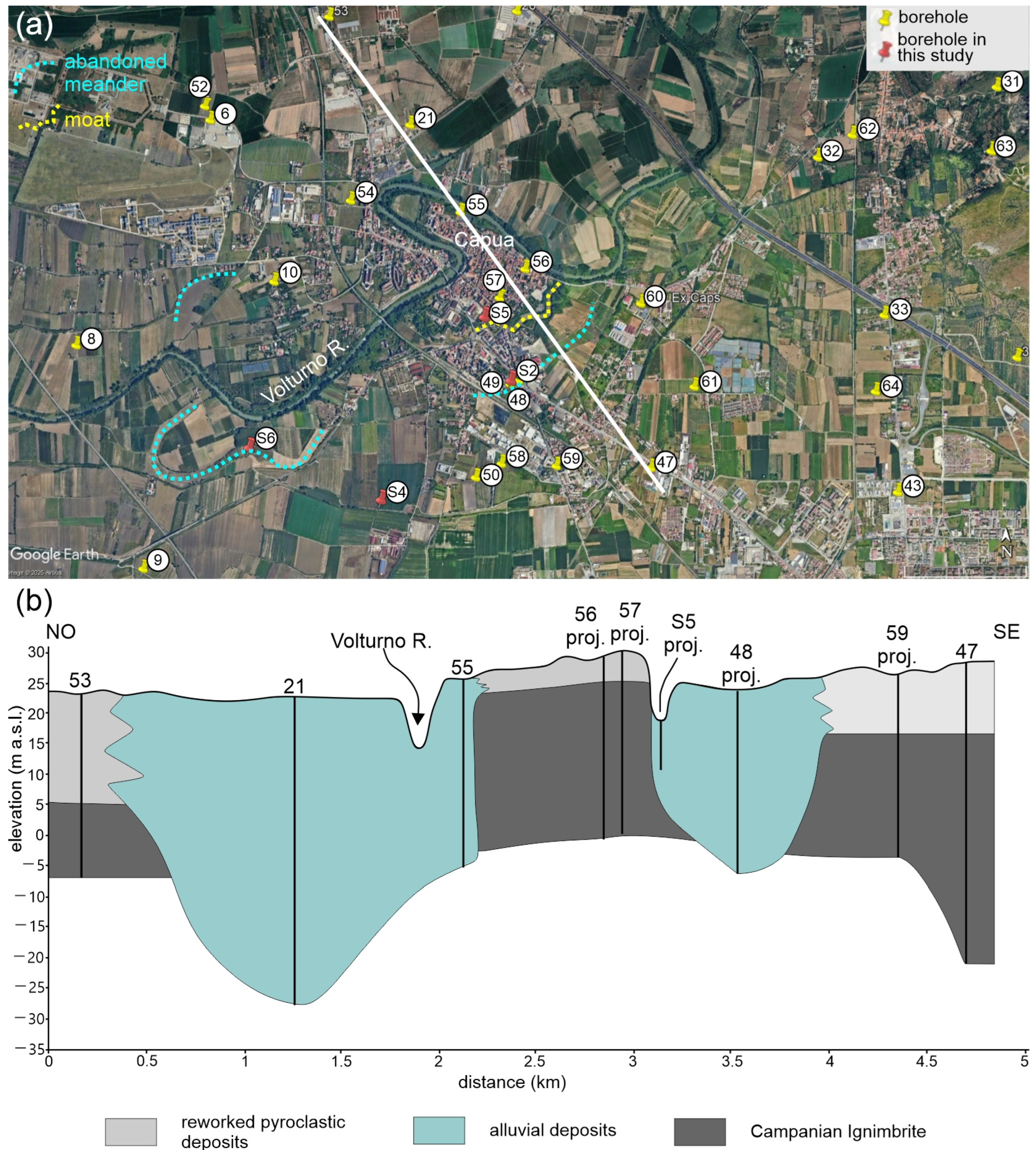
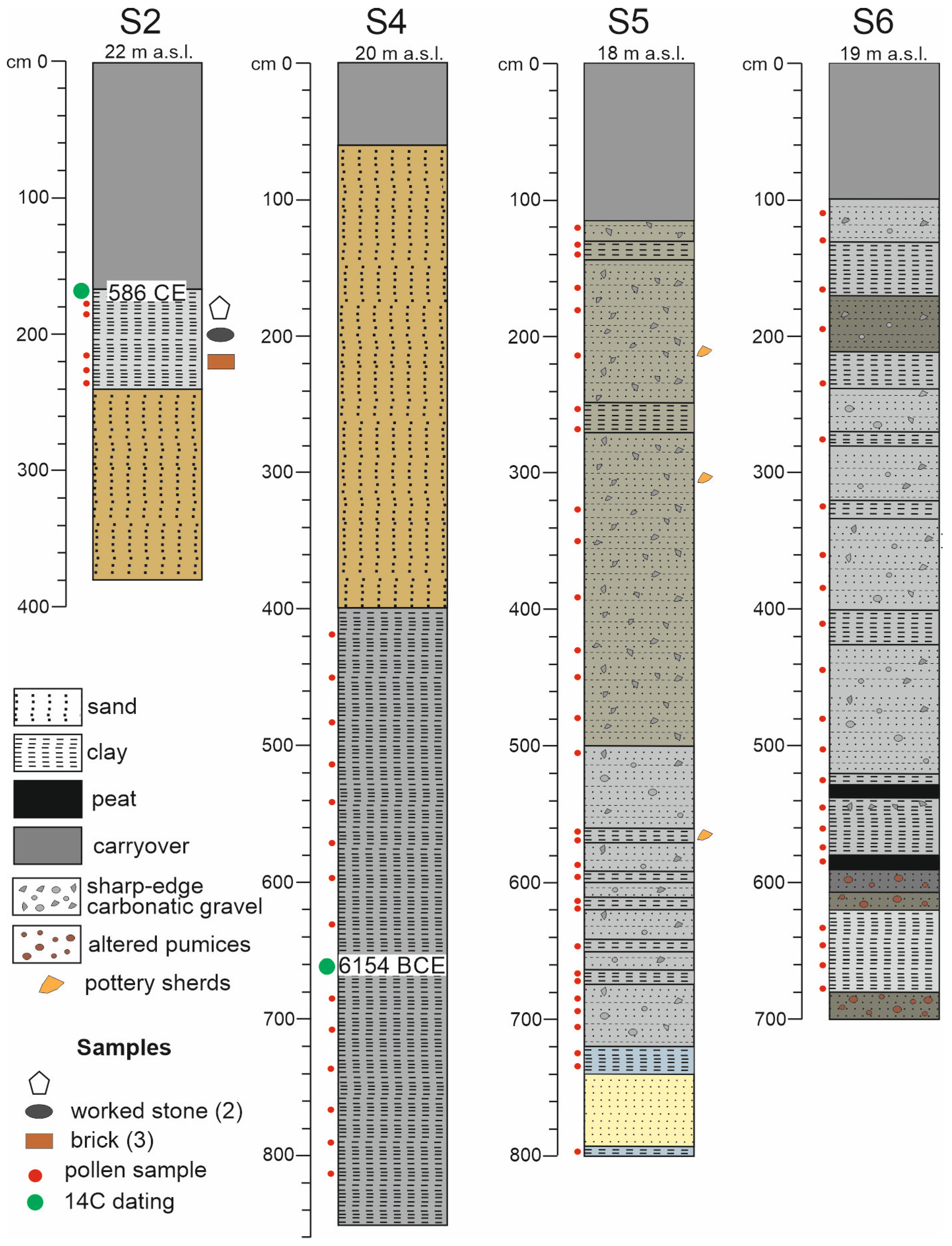

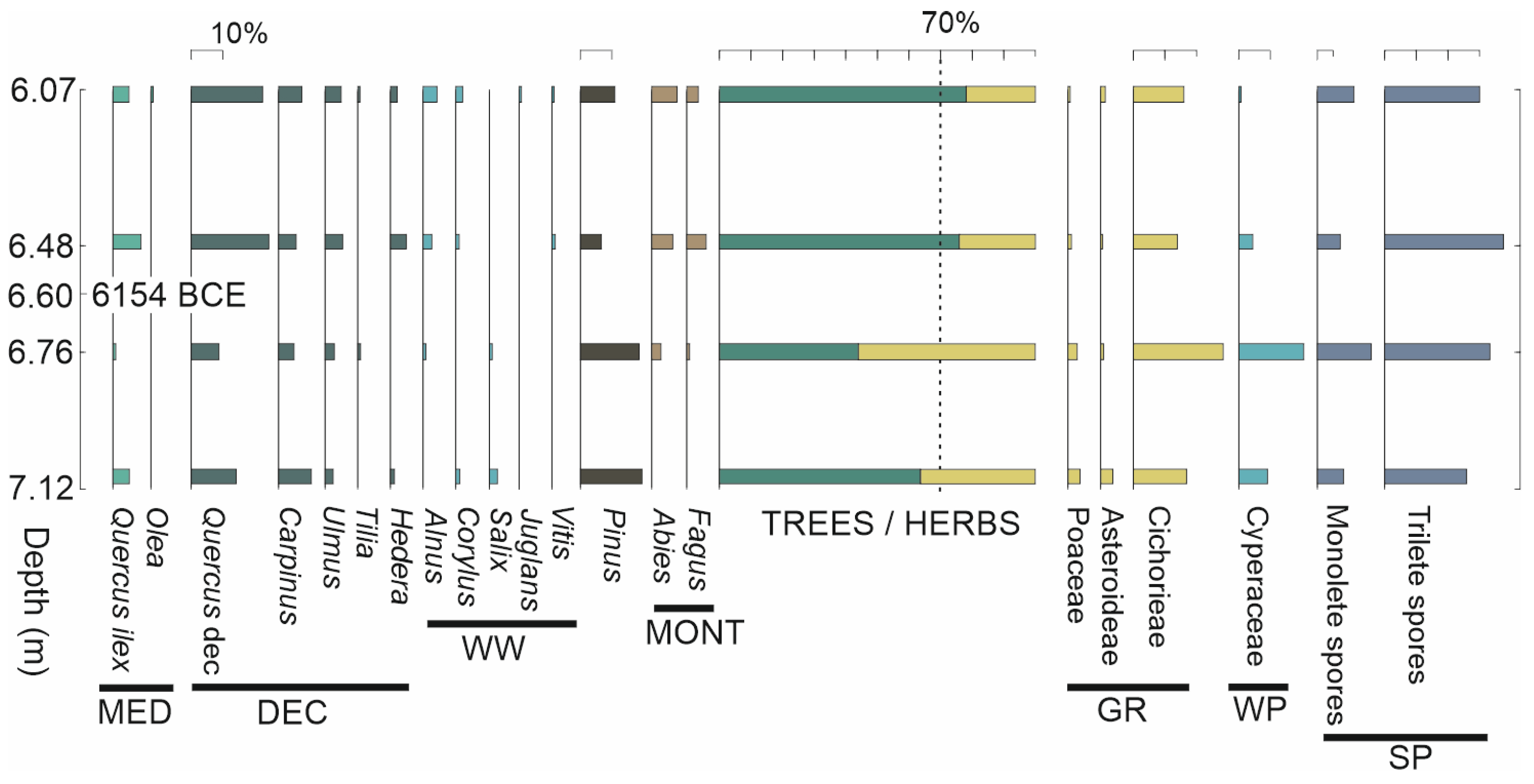
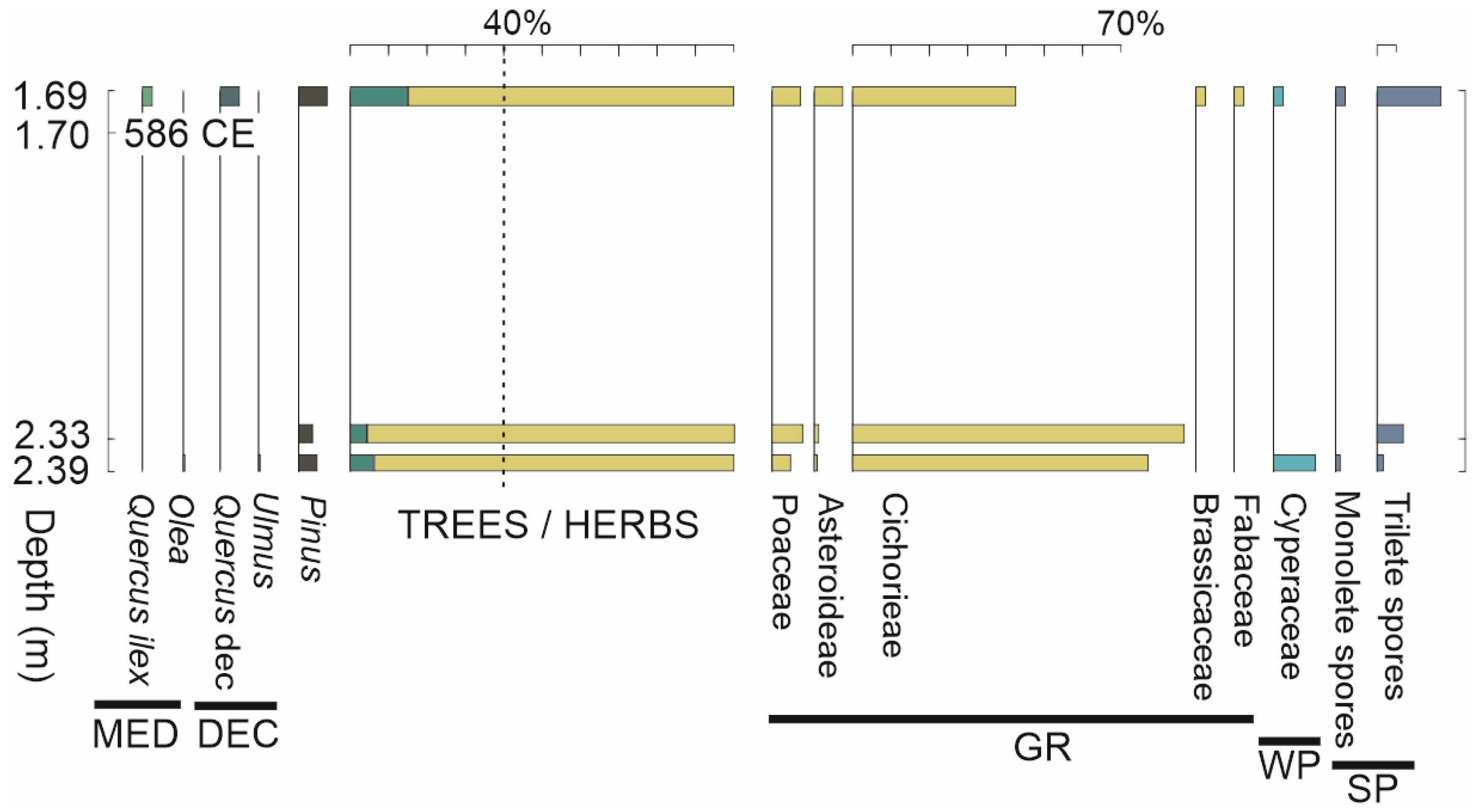
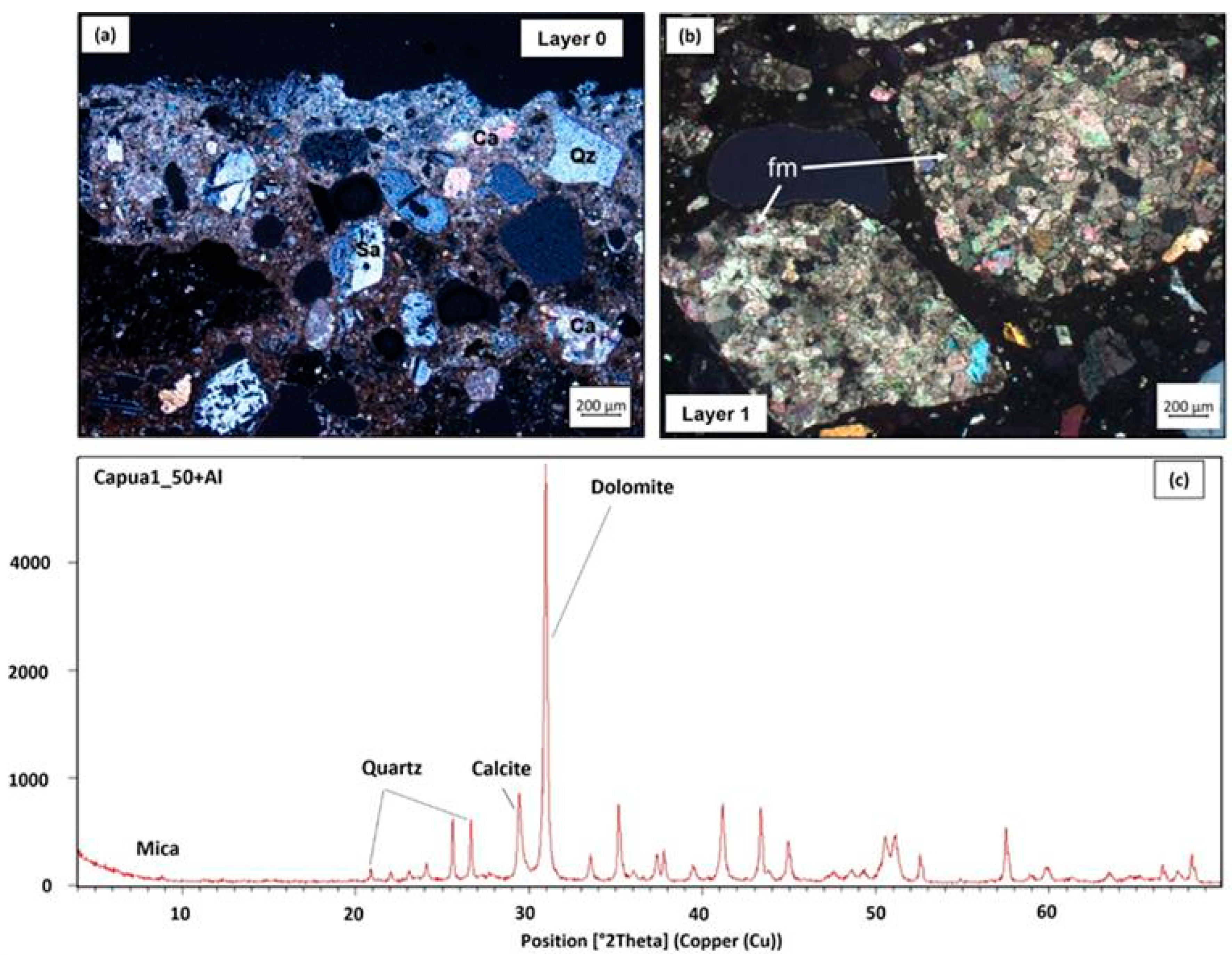
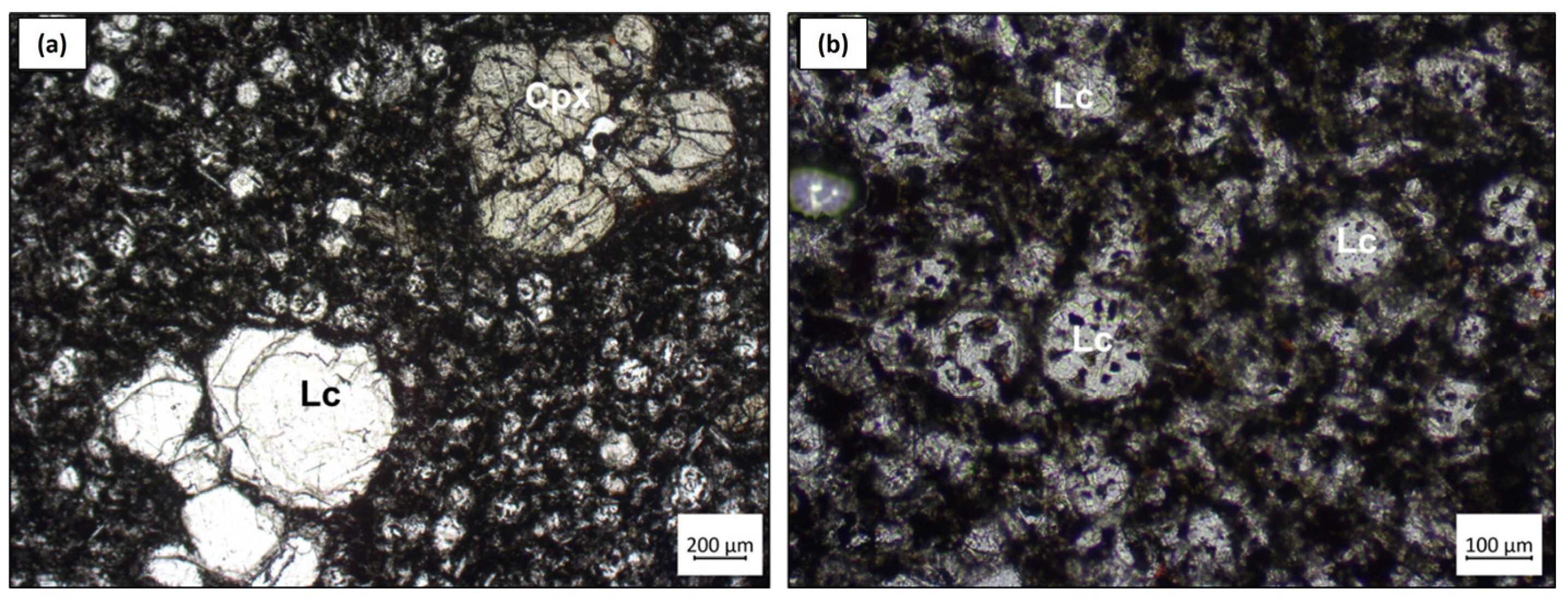

| Sample Name | Lab Sample Code | Sample Typology | RC Age | Calendric Age (1 σ) | Calendric Age (2 σ) |
|---|---|---|---|---|---|
| S2 | DSH10421_SO | Bulk Organic Matter | 1491 (26) | 559–604 AD | 546–640 AD |
| S4 | DSH10420_SO | Bulk Organic Matter | 7287 (41) | 6219–6132 BC 6098–6080 BC | 6231–6066 BC |
Disclaimer/Publisher’s Note: The statements, opinions and data contained in all publications are solely those of the individual author(s) and contributor(s) and not of MDPI and/or the editor(s). MDPI and/or the editor(s) disclaim responsibility for any injury to people or property resulting from any ideas, methods, instructions or products referred to in the content. |
© 2025 by the authors. Licensee MDPI, Basel, Switzerland. This article is an open access article distributed under the terms and conditions of the Creative Commons Attribution (CC BY) license (https://creativecommons.org/licenses/by/4.0/).
Share and Cite
Russo Ermolli, E.; Busino, N.; Marzaioli, F.; Rispoli, C.; Valente, E. First Results of Integrated Geoarchaeological Analyses in the Capua Territory (Campania, Italy). Geosciences 2025, 15, 157. https://doi.org/10.3390/geosciences15040157
Russo Ermolli E, Busino N, Marzaioli F, Rispoli C, Valente E. First Results of Integrated Geoarchaeological Analyses in the Capua Territory (Campania, Italy). Geosciences. 2025; 15(4):157. https://doi.org/10.3390/geosciences15040157
Chicago/Turabian StyleRusso Ermolli, Elda, Nicola Busino, Fabio Marzaioli, Concetta Rispoli, and Ettore Valente. 2025. "First Results of Integrated Geoarchaeological Analyses in the Capua Territory (Campania, Italy)" Geosciences 15, no. 4: 157. https://doi.org/10.3390/geosciences15040157
APA StyleRusso Ermolli, E., Busino, N., Marzaioli, F., Rispoli, C., & Valente, E. (2025). First Results of Integrated Geoarchaeological Analyses in the Capua Territory (Campania, Italy). Geosciences, 15(4), 157. https://doi.org/10.3390/geosciences15040157











